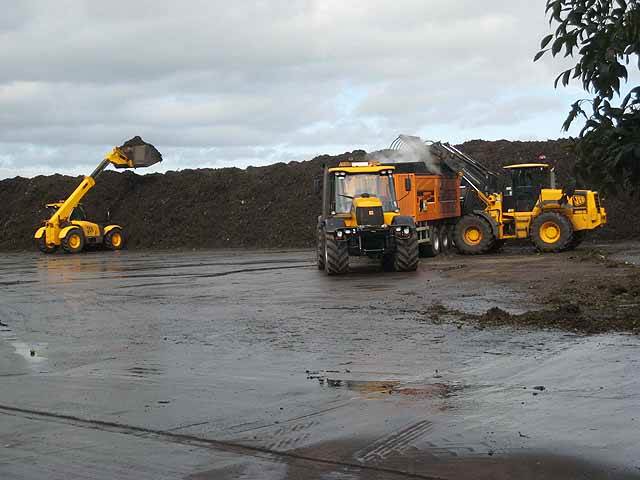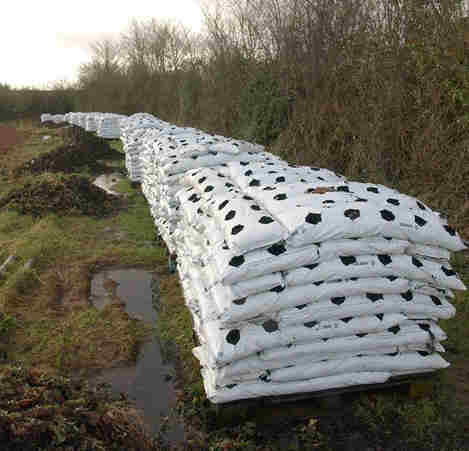- Home
- Practical Advice
- Garden Management
- Gardening without peat
Gardening without peat
Environmental and sustainability concerns make the use of peat in gardening contentious, and government legislation will shortly be greatly restricting its use. Many gardeners worry how they will be able to keep going if they can’t use peat-based potting mixes, but in reality, peat has only been a part of the gardeners repertoire for the last 40 years. Read more about the nature of peat, the peat industry and environmental concerns here.
Peat is mainly used as the principal component of potting and seed composts, but is also used as a soil conditioner and a mulch. Peat has many ideal properties for a potting compost. It is generally low in nutrients, has a low pH, low bulk density, allows movement of nutrients and has good porosity. These properties tend to make peat a very flexible material that can be adapted for most plants.
Peat origins and habitat importance
Peat formed by the accumulation of dead vegetation in wet oxygen-free conditions over thousands of years since the last ice age. Peat deposits occur in lowland bogs and upland moors, and being on the surface are relatively easily extracted. In some places, such as Ireland, peat harvesting for fuel has been a small scale industry for hundreds of years.
Peat is characteristic of several UK Biodiversity Action Plan Priority Habitats, but is commercially extracted from two, Lowland Raised Bog and Blanket Bog. Peat extraction for horticulture focuses on lowland raised bogs, it is estimated that there is around 70,000 ha of this habitat in Great Britain of which only around 9,000 ha remain as either near natural or primary degraded bog. Lowland raised bogs are extremely rare habitats, among the few where the UK has globally significant areas. Both lowland raised bogs and blanket bogs are unique and fascinating habitats, home to some rare and important plants and animals.
Gardening without peat
Environmental and sustainability concerns make the use of peat in gardening contentious, and government legislation will shortly be greatly restricting its use. Many gardeners worry how they will be able to keep going if they can’t use peat-based potting mixes, but in reality, peat has only been a part of the gardeners repertoire for the last 40 years. Read more about the nature of peat, the peat industry and environmental concerns here.
Peat is mainly used as the principal component of potting and seed composts, but is also used as a soil conditioner and a mulch. Peat has many ideal properties for a potting compost. It is generally low in nutrients, has a low pH, low bulk density, allows movement of nutrients and has good porosity. These properties tend to make peat a very flexible material that can be adapted for most plants.
Peat origins and habitat importance
Peat formed by the accumulation of dead vegetation in wet oxygen-free conditions over thousands of years since the last ice age. Peat deposits occur in lowland bogs and upland moors, and being on the surface are relatively easily extracted. In some places, such as Ireland, peat harvesting for fuel has been a small scale industry for hundreds of years.
Peat is characteristic of several UK Biodiversity Action Plan Priority Habitats, but is commercially extracted from two, Lowland Raised Bog and Blanket Bog. Peat extraction for horticulture focuses on lowland raised bogs, it is estimated that there is around 70,000 ha of this habitat in Great Britain of which only around 9,000 ha remain as either near natural or primary degraded bog. Lowland raised bogs are extremely rare habitats, among the few where the UK has globally significant areas. Both lowland raised bogs and blanket bogs are unique and fascinating habitats, home to some rare and important plants and animals.
Environmental concerns about peat extraction
Commercial peat extraction has a devastating impact on the ecology of bogs, and destroys preserved archaeological evidence. Recently, concerns have risen because peat has trapped huge quantities of carbon, and if the bogs are drained and peat is extracted, it rapidly oxidises adding to global CO2 levels. Preserving upland peatlands intact and saturated has important benefits for flood reduction and improved water quality.
![Photo: Sarah777 (Own work) [Public domain], via Wikimedia Commons](images/peat cutting Ireland.jpg)
Use of peat in horticulture
Traditionally gardeners and growers made their own potting compost using locally available materials such as leaf mould, animal manure and grit. As the horticultural industry developed, the need for standardised composts grew and in the 1930’s the “John Innes” range of mixes were developed, made from blends of ‘loam’ (composted grass turves), peat and sand. However, quality loam was both difficult to source and heavy making transport and handling expensive. In the 1970’s, peat replaced loam as it was light, cheap and easily available in Western Europe. It probably took 10-15 years for people to be confident in using the peat dominated mixes.
In 2012 total potting compost used in horticulture in the UK was ~ 3.9 million cubic metres (m m3) with peat use being ~ 2.2 m m3. In terms of peat, the amateur market used 1.4 m m3 while the professional market (commercial growers) used 0.8 m m3. In the same year the amateur market used 1.3 m m3 of peat-free compost while the commercial growers used 0.4 m m3. In 2011, the UK Government’s White Paper on the Environment contained voluntary targets for ending peat use in horticulture. The aim was for all public-body compost use to be peat-free by 2015, all amateur retail potting compost to be peat-free by 2020 and all commercial use to be peat-free by 2030. In response to this, the industry and Defra came together with all stakeholders involved (potting compost manufacturers, retailers, growers, NGO’s etc) and proposed a “road map” for how they would take the issue forward.
Since this was first written , progress on eliminating peat has been disappointing. The Committee on Climate Change’s Land use: Policies for a Net Zero UK report published at the end of January 2020 makes sweeping recommendations to reduce carbon emissions. These include increasing forest cover by 30% and big changes to agriculture, but for us the most important section deals with peat. Peatlands should be net absorbers of CO2, but emissions from our damaged peatlands were estimated at 23 million tons in 2017. The report calls for a complete ban on peat extraction and its sale, including of imports, before 2023.
There are now excellent peat-free composts available, but we are still importing nearly half a million tons each year from Ireland. We hope that this latest report, which emphasises the climate change benefits, will put some teeth into legislation originally more concerned with saving biodiversity.
Since this page was written, the UK Government has again announced a ban on the sale of peat based composts "by the end of 2024" . This however only applies to domestic use, and disappointingly commercial growers can continue peat use until 2030.
Industrial peat-harvesting in the Bog of Allen, County Offaly, Ireland
Industrial peat-harvesting in the Bog of Allen, County Offaly, Ireland
Use of peat in horticulture
Traditionally gardeners and growers made their own potting compost using locally available materials such as leaf mould, animal manure and grit. As the horticultural industry developed, the need for standardised composts grew and in the 1930’s the “John Innes” range of mixes were developed, made from blends of ‘loam’ (composted grass turves), peat and sand. However, quality loam was both difficult to source and heavy making transport and handling expensive. In the 1970’s, peat replaced loam as it was light, cheap and easily available in Western Europe. It probably took 10-15 years for people to be confident in using the peat dominated mixes.
In 2012 total potting compost used in horticulture in the UK was ~ 3.9 million cubic metres (m m3) with peat use being ~ 2.2 m m3. In terms of peat, the amateur market used 1.4 m m3 while the professional market (commercial growers) used 0.8 m m3. In the same year the amateur market used 1.3 m m3 of peat-free compost while the commercial growers used 0.4 m m3. In 2011, the UK Government’s White Paper on the Environment contained voluntary targets for ending peat use in horticulture. The aim was for all public-body compost use to be peat-free by 2015, all amateur retail potting compost to be peat-free by 2020 and all commercial use to be peat-free by 2030. In response to this, the industry and Defra came together with all stakeholders involved (potting compost manufacturers, retailers, growers, NGO’s etc) and proposed a “road map” for how they would take the issue forward.
Since this was first written , progress on eliminating peat has been disappointing. The Committee on Climate Change’s Land use: Policies for a Net Zero UK report published at the end of January 2020 makes sweeping recommendations to reduce carbon emissions. These include increasing forest cover by 30% and big changes to agriculture, but for us the most important section deals with peat. Peatlands should be net absorbers of CO2, but emissions from our damaged peatlands were estimated at 23 million tons in 2017. The report calls for a complete ban on peat extraction and its sale, including of imports, before 2023.
There are now excellent peat-free composts available, but we are still importing nearly half a million tons each year from Ireland. We hope that this latest report, which emphasises the climate change benefits, will put some teeth into legislation originally more concerned with saving biodiversity.
Since this page was written, the UK Government has again announced a ban on the sale of peat based composts "by the end of 2024" . This however only applies to domestic use, and disappointingly commercial growers can continue peat use until 2030.
![Photo: Sarah777 (Own work) [Public domain], via Wikimedia Commons](images/peat cutting Ireland.jpg)
Ford Moss is a lowland raised peat-bog managed by the Northumberland Wildlife Trust.
Environmental concerns about peat extraction
Commercial peat extraction has a devastating impact on the ecology of bogs, and destroys preserved archaeological evidence. Recently, concerns have risen because peat has trapped huge quantities of carbon, and if the bogs are drained and peat is extracted, it rapidly oxidises adding to global CO2 levels. Preserving upland peatlands intact and saturated has important benefits for flood reduction and improved water quality.
![Andrew Curtis [CC-BY-SA-2.0 (http://creativecommons.org/licenses/by-sa/2.0)], via Wikimedia Commons](images/lowland raised bog.jpg)

Composted (or aged) bark
Composted or aged pine, spruce and larch bark, which is a by-product of the building industry, is used in many peat-based mixes to improve their drainage. In general it is a fair replacement for peat, with a low pH and nutrient status, and is widely available, but can be rather toxic to plants if not well prepared and aged.
Wood Fibre
This is a relatively new product made mechanically by passing woody material though screw presses to produce a cotton wool-like material, to which combined nitrogen is added. It has a low pH, variable nutrient content and high porosity.
Home produced compost
Many gardeners recycle their waste plant material onto their compost heap. The product is an excellent mulch and soil conditioner, but it takes care to use it as a potting compost. Well-made garden compost takes at least 12 months to produce so that everything has decomposed fully. Un-rotted material can damage plant growth. It should then be screened through a sieve to remove lumpy or coarse material. Home compost naturally contains some valuable nutrients, which makes it too strong for seeds, propagation and tender plants, so should be diluted 50:50 with sterilised loam or garden soil. It will still be liable to contain surviving pests, diseases and weeds.
Soil conditioners
Putting on bulky organic material improves soils structure and texture, helping both drainage and moisture retention. Garden compost is excellent as are well matured horse and farmyard manure, and spent mushroom compost, although the latter is bad for chalk-hating plants. It is essential all these are well matured, and they are best dug into the soil in the Autumn, or applied as a mulch in spring.
Composting facility at Codlaw Hill Farm which processes the contents of 7,000 brown wheelie bins in Tynedale District

Composting facility at Codlaw Hill Farm which processes the contents of 7,000 brown wheelie bins in Tynedale District
Composted (or aged) bark
Composted or aged pine, spruce and larch bark, which is a by-product of the building industry, is used in many peat-based mixes to improve their drainage. In general it is a fair replacement for peat, with a low pH and nutrient status, and is widely available, but can be rather toxic to plants if not well prepared and aged.
Wood Fibre
This is a relatively new product made mechanically by passing woody material though screw presses to produce a cotton wool-like material, to which combined nitrogen is added. It has a low pH, variable nutrient content and high porosity.
Home produced compost
Many gardeners recycle their waste plant material onto their compost heap. The product is an excellent mulch and soil conditioner, but it takes care to use it as a potting compost. Well-made garden compost takes at least 12 months to produce so that everything has decomposed fully. Un-rotted material can damage plant growth. It should then be screened through a sieve to remove lumpy or coarse material. Home compost naturally contains some valuable nutrients, which makes it too strong for seeds, propagation and tender plants, so should be diluted 50:50 with sterilised loam or garden soil. It will still be liable to contain surviving pests, diseases and weeds.
Soil conditioners
Putting on bulky organic material improves soils structure and texture, helping both drainage and moisture retention. Garden compost is excellent as are well matured horse and farmyard manure, and spent mushroom compost, although the latter is bad for chalk-hating plants. It is essential all these are well matured, and they are best dug into the soil in the Autumn, or applied as a mulch in spring.
See also: Compost and fertility
Download How to: Make your own compost
Further information available from this page:
Natural England booklet on composting and peat-free gardening
Page written by Paul Alexander Reviewed and compiled by Steve Head
See also: Compost and fertility
Download How to: Make your own compost
Further information available from this page:
Natural England booklet on composting and peat-free gardening
Page written by Paul Alexander Reviewed and compiled by Steve Head
Ford Moss is a lowland raised peat-bog managed by the Northumberland Wildlife Trust.
Substitutes for peat
The goal is to replace peat with sustainable components, preferably sourced close to market. This will need a variety of raw materials rather than just one source, and they will need to be blended to balance their physical and chemical properties as well as interacting with any added nutrition and managing the provision of water for the plant in a predictable fashion. Read more about these potential substitutes in our leaflet here.
Coir
Coir compost originates from waste fibres from the outer shell of coconuts, and the main sources are India and Sri Lanka. Coir has a number of useful properties, including its low nutrient status, high porosity and low bulk density. On the other hand, it does not readily retain nutrients and is easily leached, and there are environmental sustainability issues about its production and transport.
Composted green waste
This “green compost” is made by bulk-composting material from the waste stream that would otherwise go into landfill. It has high nutrient concentrations and good water holding capacity, but isn’t reliable for growing mixtures, because of inconsistency, high pH and tendency for contamination. It is probably best use as a nutrient rich additive, at up to 25% in other mixes.

Huge quantity of extracted peat stacked for application to horticultural fields.
Most of the UK’s 2.2million m3 horticultural peat consumption is imported from Ireland
Substitutes for peat
The goal is to replace peat with sustainable components, preferably sourced close to market. This will need a variety of raw materials rather than just one source, and they will need to be blended to balance their physical and chemical properties as well as interacting with any added nutrition and managing the provision of water for the plant in a predictable fashion. Read more about these potential substitutes in our leaflet here.
Coir
Coir compost originates from waste fibres from the outer shell of coconuts, and the main sources are India and Sri Lanka. Coir has a number of useful properties, including its low nutrient status, high porosity and low bulk density. On the other hand, it does not readily retain nutrients and is easily leached, and there are environmental sustainability issues about its production and transport.
Composted green waste
This “green compost” is made by bulk-composting material from the waste stream that would otherwise go into landfill. It has high nutrient concentrations and good water holding capacity, but isn’t reliable for growing mixtures, because of inconsistency, high pH and tendency for contamination. It is probably best use as a nutrient rich additive, at up to 25% in other mixes.
Huge quantity of extracted peat stacked for application to horticultural fields.
Most of the UK’s 2.2million m3 horticultural peat consumption is imported from Ireland

![Andrew Curtis [CC-BY-SA-2.0 (http://creativecommons.org/licenses/by-sa/2.0)], via Wikimedia Commons](images/lowland raised bog.jpg)













